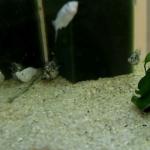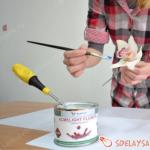Clerodendrum: care and reproduction at home
Clerodendrum is a very beautiful plant and I personally fell in love with it for its beautiful white flowers, which are so similar to a bell (as a child I really loved field and home bells) from which a red corolla is visible. The leaves of this plant are shaped like hearts in a bright green color. There are many types and varieties of clerodendrum, but at home they are found mainly in brilliant clerodendrum and Mrs. Thomson's clerodendrum.
The flower came to us from the warm and sunny tropics and therefore it needs to be provided with good lighting. But at the same time keep out of direct sunlight. If the clerodendrum does not have enough light at home, then it will definitely shed its leaves. This is especially evident in winter, when even people lack the gentle sun.
The plant will feel best on an east or west window. But in the south, from an overabundance of the Sun, its leaves will begin to turn yellow and fall off. If your windows are located only on the south side, then you will have to use a curtain, or blinds, which will protect the plant from direct sunlight. On the northern windows, the illumination of everyday life is not enough, but from the lack of light, the clerodendrum will not delight you with its colors.
In spring and summer, the clerodendrum feels great at a temperature of 20-25 C, but in winter it is desirable for it to provide a cooler temperature of up to 13C. In winter, the clerodendrum has a dormant period, during which it sheds part of the leaves.
Clerodendrum needs high soil and air moisture. To provide the plant with normal humidity, it is recommended to put wet expanded clay on the pallet and water the plant abundantly twice a week. In winter, watering is reduced to two times a month.
Humidity must be monitored constantly, avoiding both waterlogging and drying out, as this can cause leaves to drop. In summer, it is recommended to regularly spray the flower and wipe the leaves once a week with a damp cloth. Try not to place the plant near heating appliances.
WHAT SOIL DOES CLERODENDRUM PREFER
Clerodendrum at home responds well to slightly acidic soil, in such a land it feels great, which affects growth and abundant flowering.
The soil can be prepared independently by taking one part of clay soil, leafy soil, sand and peat. The prepared components must be mixed and used for their intended purpose. You can buy the substrate in the store, but in addition you need to add a little sand to it.
The plant needs top dressing starting in spring. You need to feed every two weeks with organic and mineral fertilizers. Buy fertilizers in the store and use following the instructions.
CUTTING CLERODENDRUM
Clerodendrum is considered a liana and at home can reach a height of more than four meters, therefore, the plant must be cut regularly.
The best time for pruning is the rest period (late winter, early spring). You need to cut off all lignified shoots by a third. Such pruning is done in order to stimulate the plant to a long and abundant flowering.
Clerodendrum at home can be given the appearance of a pretty bush; for this, almost the entire plant is cut off, leaving about seven centimeters from the ground. Such pruning is carried out in early spring, when growth begins.
If you want to grow a clerodendrum in the form of a tree, then you need to cut off all the side shoots, leaving one that is healthier and stronger.
All new shoots also need to be removed, and when the trunk reaches a height of 0.6-0.8 meters, it is shortened a little, and the side shoots that will appear after that need to be pinched off, forming a crown.
From all sprouts that begin to form at the root, you need to remove.
Some types of clerodendrum have such a feature: they regulate their growth themselves, specifically do not allow some shoots to develop, drying them. Some amateur flower growers are not aware of this feature and get upset, thinking they are doing something wrong.
HOW TO PLANT CLERODENDRUM AT HOME
The plant is transplanted in early spring, after the pruning procedure has been carried out. Transplant the clerodendrum by transshipment to minimize root damage. For transplantation, a larger pot is taken, on the bottom of which a layer of expanded clay is placed (you can take small pebbles, broken bricks, etc.).
Then they put the earth in a pot and plant a clerodendrum. Immediately after transplantation, the plant should be watered with a solution of fertilizers, for better engraftment, and then transferred to a warm room. Young plants need to be repotted every year, while older plants can be repotted once a year.
REPRODUCTION IN HOME CONDITIONS
Clerodendrum can be propagated in two ways: by seeds and cuttings, but propagation by cuttings is most often used.
The cut stalk can be placed in a pot with a mixture of peat and sand, create greenhouse conditions (cover with oilcloth and put in a warm place).
Oilcloth is slightly opened every day to water a little and feed the plant.
When the leaves begin to appear, remove the oilcloth completely.
A rooted cutting can be transplanted only after a year. You can place the cutting for propagation in water and wait until it takes root.
As soon as the roots appear, we transplant it into a pot and put it in a dark place.
As you can see, the clerodendrum plant is capricious and caring for it at home causes some difficulties, but if you are not too lazy and follow all the above recommendations, you will enjoy beautiful flowers for a very long time.







